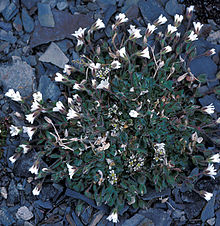
Svalbard, also known as Spitsbergen, or Spitzbergen, is a Norwegian archipelago in the Arctic Ocean. North of mainland Europe, it is about midway between the northern coast of Norway and the North Pole. The islands of the group range from 74° to 81° north latitude, and from 10° to 35° east longitude. The largest island is Spitsbergen, followed by Nordaustlandet and Edgeøya. The largest settlement is Longyearbyen.
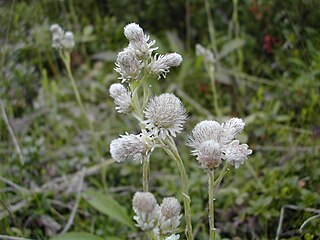
Antennaria alpina is a European and North American species of plant in the family Asteraceae. Antennaria alpina is native to mountainous and subarctic regions of Scandinavia, Greenland, Alaska, and the Canadian Arctic, extending south at high altitudes in mountains in the Rocky Mountains south to Montana and Wyoming.

Silene acaulis, known as moss campion or cushion pink, is a small mountain-dwelling wildflower that is common all over the high arctic and tundra in the higher mountains of Eurasia and North America,. It is an evergreen perennial flowering plant in the carnation family Caryophyllaceae.

Oxyria digyna is a species of flowering plant in the buckwheat family (Polygonaceae). It is native to arctic regions and mountainous parts of the Northern Hemisphere.

Pedicularis dasyantha, the woolly lousewort or arctic hairy lousewort, is a plant native to the high arctic areas of Svalbard, Novaya Zemlya and the bordering mainland, and the western Taymyr Peninsula. In Svalbard it is restricted to the main island, Spitsbergen.
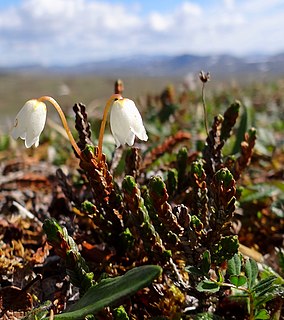
Cassiope tetragona is a plant native to the high Arctic and northern Norway, where it is found widely.

Draba lactea, the Lapland whitlow-grass or milky whitlow-grass, is a flower common throughout the high Arctic. It stretches further south in mountainous areas of Norway, Montana, Canada, and Greenland.
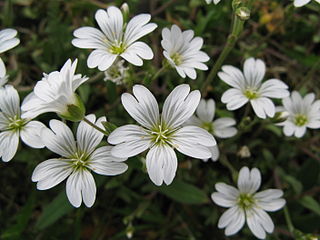
Cerastium is a genus of annual, winter annual, or perennial plants belonging to the family Caryophyllaceae. They are commonly called mouse-ear chickweed. Species are found nearly worldwide but the greatest concentration is in the northern temperate regions. There are about 200 species. A number are common weeds in fields and on disturbed ground.

Viola sororia, known commonly as the common blue violet, is a short-stemmed herbaceous perennial plant that is native to eastern North America. It is known by a number of common names, including common meadow violet, purple violet, woolly blue violet, hooded violet, and wood violet. Its cultivar 'Albiflora' has gained the Royal Horticultural Society's Award of Garden Merit. This perennial plant species is distributed in the eastern half of the United States, Canada and a part of Eastern Mexico. Their native habitats are rich, moist woods, and swamps located in the eastern half of the United States and Canada.

Harrimanella is a genus of flowering plant in the heath family Ericaceae, with a single species, Harrimanella hypnoides, also known as moss bell heather or mos heather. It was originally named Cassiope hypnoides by Linnaeus (1737) in his Flora Lapponica, but Harrimanella hypnoides is now the accepted name at Integrated Taxonomic Information System. The species name hypnoides means 'like Hypnum ', which is a genus mosses.

Dagny Tande Lid was a Norwegian painter, illustrator and poet. She is most noted for her drawings of plants and is known for her own illustrated poetry collections and for her botanical illustrations of Norwegian postage stamps.

Liatris pycnostachya, the prairie blazing star or cattail blazing star, is a perennial plant native to the tallgrass prairies of the central United States.

Rosa acicularis is a flowering plant in the Rosaceae family. It is commonly known as the prickly wild rose, prickly rose, bristly rose, wild rose or Arctic rose. It is a species of wild rose with a Holarctic distribution in northern regions of Asia, Europe, and North America.

Cerastium glomeratum is a species of flowering plant in the family Caryophyllaceae known by the common names sticky mouse-ear chickweed and clammy chickweed. It is probably native to Eurasia but it is known on most continents as an introduced species. It grows in many types of habitat. The blooming period is February, March, April, and May.
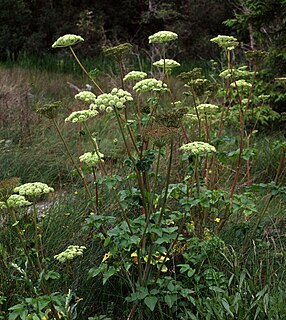
Angelica lucida is a species of angelica known by the common names seacoast angelica and sea-watch. It is also one of many species in the celery family which are casually called wild celery.

Benjamin Leigh Smith was an English Arctic explorer and yachtsman. He is the grandson of the Radical abolitionist William Smith.
Luzula wahlenbergii, commonly known as Wahlenberg's woodrush or reindeer wood-rush, is a perennial species of plant in the genus Luzula of the (rush) family Juncaceae.

Erigeron humilis is an arctic and alpine species of flowering plants in the family Asteraceae known as Arctic Alpine fleabane. It is widespread across the colder regions of the Northern Hemisphere. In North America, it has been found in Alaska, much of Canada, Greenland, and the Rocky Mountains of the United States as far south as Colorado. In Eurasia, it has been found in Scandinavia, and the Chukotka region in the Russian Far East.

Ranunculus arcticus, the birdfoot buttercup, is a species of buttercup in the family Ranunculaceae. It has a circumpolar distribution in Northern Europe, Northern Asia and North America.

Eriophorum brachyantherum, the closed-sheath cotton-grass, short-anthered cotton-grass or northland cottonsedge, is a species that is a part of the Cyperaceae or sedge family. It is commonly found in wet areas, such as bogs and cooler climate zones.
